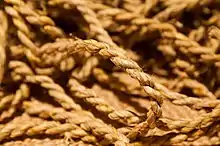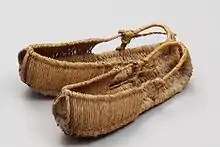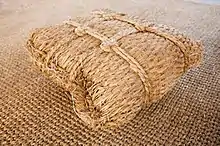Saekki
Saekki (Korean: 새끼) is a rope made of woven straw.[1][2] It was an important household item used in pre-modern agricultural Korea.[3]
| Saekki | |
 | |
| Korean name | |
|---|---|
| Hangul | 새끼 |
| Revised Romanization | saekki |
| McCune–Reischauer | saekki |
| IPA | [sɛ.k͈i] |
History
Grey stoneware (hard pottery) from the Proto–Three Kingdoms era (2nd century BCE‒3rd century CE) demonstrates evidence of saekki.[3] Ceramic sculptures of jipsin (straw shoes) from Silla (57 BCE‒935 CE) indicates the usage of saekki in this period.[3]
During the Joseon era (1392–1897), sakgye (a guild of the tribute merchants of ropes) was one of the gonggye (guilds of tribute merchants, the government-licensed purchasing agents) that had monopolistic rights for supplying government requirements.[3][4]
During the Japanese forced occupation (1910–1945), a large amount of saekki along with gamani (straw bags) were looted for military use by the Imperial Japanese Army.[3]
Saekki was widely used until the 1960s.[3] In the 1970s, the use of saekki waned with the spread of plastic, vinyl, and synthetic fiber ropes. Saekki faced a resurgence at the end of the 20th century due to growing interest in traditional handicraft in recent decades.[3]
Uses
Saekki was used to make common items such as jipsin (straw shoes), gamani (straw bags), kojige (A-shaped carrier frames) and goppi (cattle halters).[3] It was also used as geumjul (taboo ropes) to ward off malignant influences in Korean folk religion.[3]
See also
References
- "새끼". Korean–English Learners' Dictionary. Retrieved 4 January 2018.
- Kim, Jung-dae (December 2012). "The Significance of Cultural Space in the Language of Seomjin Riverside facing Yeongnam Area" (PDF). Eo-Mun-Lon-Chong. 57: 31–64. ISSN 1225-3928. Retrieved 4 January 2018.
- Park, Dae-soon. "Saekki". Encyclopedia of Korean Culture (in Korean). Academy of Korean Studies. Retrieved 4 January 2018.
- Seo, Yeong-bo; Sim, Sang-gyu (1971) [1808]. "Jaktaesik". Mangi yoram (in Korean). Translated by Research Institute of Korean Studies, Korea University. Institute for the Translation of Korean Classics. Retrieved 4 January 2018.



.jpg.webp)

.jpg.webp)